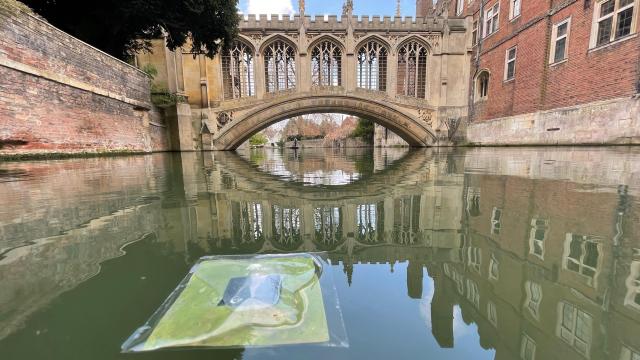What if we could copy how plants create their own energy — and use it to power our world?
In a study published last week in Nature, researchers say they’ve created a prototype of a device with the potential to do just that. The team from the University of Cambridge described a floating solar “leaf,” which uses the power of the sun and the water to create fuel.
“Our artificial leaves work similarly to plant leaves,” Virgil Andrei, a research fellow at the University of Cambridge and one of the study’s coauthors, said in an email. “However, instead of sugars, we are producing useful chemicals.”
The leaves that Andrei and his colleagues have created aren’t solar panels, which create electricity using solar energy. Rather, this technology uses sunlight to produce a chemical reaction — in this case, to create the components needed for liquid fuel. The leaves copy the photosynthetic process of plants using two different kinds of fuel cells made from lead perovskite, a type of solar cell, to produce the building blocks for syngas.
Synthesis gas, or syngas, is a combination of hydrogen and carbon monoxide molecules, and it’s a crucial component of many industrial processes. Syngas can also be used as a form of fuel itself, and there’s hope that syngas could take the place of other, dirtier fuels in processes like aviation and car engines. But syngas is often made using fossil fuels like coal and natural gas, meaning that it is still a significant source of emissions. The promise of devices like the leaf prototype is that they could eliminate the problems that come with traditional fossil fuel-based syngas.
The team at Cambridge had developed a previous version of the leaf in 2019, which was able to produce the components of syngas from sunlight. But that technology was large and heavy, confining it to very specific applications and locations.
“Most [artificial leaf] prototypes are quite complex, and can only produce fuels on a small, laboratory scale,” Andrei said. “Here, we wanted to redesign the leaf structure, in order to make them compatible with scalable fabrication methods and materials, and ultimately suitable for real-world applications. For this purpose, we trimmed down the device weight by depositing our light absorbers on thin, flexible substrates. As a result, our devices became so light that they were able to float on water, similar to lotus leaves.”
Andrei said that the new versions are still just prototypes, and more testing is needed on how well they function in real-world settings. But the design of this new leaf, Andrei said, opens up the possibilities for the technology.
“These leaves could be assembled into floating farms, which could be placed on lakes, rivers, and shorelines,” he said. “The lightweight, flexible leaves could be easily transported to remote settlements (e.g. islands), enabling decentralized fuel production. Leaves could make further use of polluted waters like mining lakes, or near ports. Moreover, they could prevent moisture evaporation from irrigation canals, which is very topical when considering the current droughts.”
